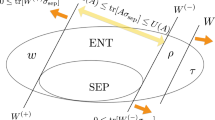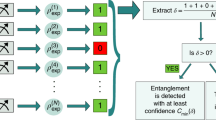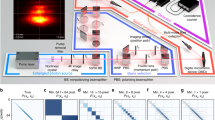Abstract
Nearly all protocols requiring shared quantum information1—such as quantum teleportation2 or key distribution3—rely on entanglement between distant parties. However, entanglement is difficult to characterize experimentally. All existing techniques for doing so, including entanglement witnesses4,11,12 or Bell inequalities5, disclose the entanglement of some quantum states but fail for other states; therefore, they cannot provide satisfactory results in general. Such methods are fundamentally different from entanglement measures that, by definition, quantify the amount of entanglement in any state. However, these measures suffer from the severe disadvantage that they typically are not directly accessible in laboratory experiments. Here we report a linear optics experiment in which we directly observe a pure-state entanglement measure, namely concurrence6. Our measurement set-up includes two copies of a quantum state: these ‘twin’ states are prepared in the polarization and momentum degrees of freedom of two photons, and concurrence is measured with a single, local measurement on just one of the photons.
This is a preview of subscription content, access via your institution
Access options
Subscribe to this journal
Receive 51 print issues and online access
$199.00 per year
only $3.90 per issue
Buy this article
- Purchase on Springer Link
- Instant access to full article PDF
Prices may be subject to local taxes which are calculated during checkout



Similar content being viewed by others
References
Nielsen, M. & Chuang, I. Quantum Computation and Quantum Information (Cambridge Univ. Press, Cambridge, UK, 2000)
Bennett, C. H. et al. Teleporting an unknown quantum state via dual classical and Einstein-Podolsky-Rosen channels. Phys. Rev. Lett. 70, 1895–1899 (1993)
Ekert, A. K. Quantum cryptography based on Bells theorem. Phys. Rev. Lett. 67, 661–663 (1991)
Horodecki, M., Horodecki, P. & Horodecki, R. Separability of mixed states: necessary and sufficient conditions. Phys. Lett. A 223, 1–8 (1996)
Bell, J. S. On the Einstein Podolsky Rosen paradox. Physics 1, 195–200 (1964)
Bennet, C. H., DiVincenzo, D. P., Smolin, J. A. & Wootters, W. K. Mixed-state entanglement and quantum error correction. Phys. Rev. A 54, 3824–3851 (1996)
Wootters, W. K. Entanglement of formation of an arbitrary state of two qubits. Phys. Rev Lett. 80, 2245–2248 (1998)
Vidal, G. & Werner, R. F. Computable measure of entanglement. Phys. Rev. A 65, 032314 (2002)
Sancho, J. M. G. & Huelga, S. F. Measuring the entanglement of bipartite pure states. Phys. Rev. A 61, 042303 (2000)
White, A., James, D., Eberhard, P. & Kwiat, P. Nonmaximally entangled states: Production, characterization, and utilization. Phys. Rev. Lett. 83, 3103–3107 (1990)
Häffner, H. et al. Scalable multiparticle entanglement of trapped ions. Nature 438, 643–646 (2005)
Leibfried, D. et al. Creation of a six-atom ‘Schrödinger cat’ state. Nature 438, 639–642 (2005)
Horodecki, P. Measuring quantum entanglement without prior state reconstruction. Phys. Rev. Lett. 90, 167901 (2003)
Mintert, F., Kuś, M. & Buchleitner, A. Concurrence of mixed multi-partite quantum states. Phys. Rev. Lett. 95, 260502 (2005)
Brun, T. A. Measuring polynomial functions of states. Quant. Inform. Comput. 4, 401–408 (2004)
Kwiat, P. G. Hyper entangled states. J. Mod. Opt. 44, 2173–2184 (1997)
Barbieri, M., Cinelli, C., Mataloni, P. & Martini, F. D. Polarization-momentum hyperentangled states: Realization and characterization. Phys. Rev. A 72, 052110 (2005)
Boschi, D., Branca, S., DeMartini, F., Hardy, L. & Popescu, S. Experimental realization of teleporting an unknown pure quantum state via dual classical and Einstein-Podolsky-Rosen channels. Phys. Rev. Lett. 80, 1121–1125 (1998)
Englert, B.-G., Kurtsiefer, C. & Weinfurter, H. Universal unitary gate for single-photon two-qubit states. Phys. Rev. A 63, 032303 (2003)
Kwiat, P. G., Waks, E., White, A. G., Appelbaum, I. & Eberhard, P. H. Ultrabright source of polarization-entangled photons. Phys. Rev. A 60, R773–R776 (1999)
Rarity, J. & Tapster, P. Experimental violation of Bell's inequality based on phase and momentum. Phys. Rev. Lett. 64, 2495–2498 (1990)
Fiorentino, M. & Wong, F. N. C. Deterministic controlled-not gate for single-photon two-qubit quantum logic. Phys. Rev. Lett. 93, 070502 (2004)
Acknowledgements
We acknowledge support from the Brazilian agencies CNPq, CAPES, PRONEX, FUJB and FAPERJ. This work was performed as part of the Brazilian Millennium Institute for Quantum Information, and was supported by a fellowship within the postdoctoral programme of the German Academic Exchange Service (DAAD) as well as by a Feodor Lynen fellowship of the Alexander von Humboldt foundation. We are indebted to C. H. Monken for discussions.
Author information
Authors and Affiliations
Corresponding author
Ethics declarations
Competing interests
Reprints and permissions information is available at npg.nature.com/reprintsandpermissions. The authors declare no competing financial interests.
Rights and permissions
About this article
Cite this article
Walborn, S., Souto Ribeiro, P., Davidovich, L. et al. Experimental determination of entanglement with a single measurement. Nature 440, 1022–1024 (2006). https://doi.org/10.1038/nature04627
Received:
Accepted:
Published:
Issue Date:
DOI: https://doi.org/10.1038/nature04627
This article is cited by
-
Learning quantum systems
Nature Reviews Physics (2023)
-
Ground-state and thermal entanglements in non-Hermitian XY system with real and imaginary magnetic fields
Quantum Information Processing (2023)
-
Detecting and embedding high-dimensional genuine multipartite entanglement states
Quantum Information Processing (2022)
-
Quantum tomography of entangled qubits by time-resolved single-photon counting with time-continuous measurements
Quantum Information Processing (2022)
-
The RT formula and its discontents: spacetime and entanglement
Synthese (2021)
Comments
By submitting a comment you agree to abide by our Terms and Community Guidelines. If you find something abusive or that does not comply with our terms or guidelines please flag it as inappropriate.



